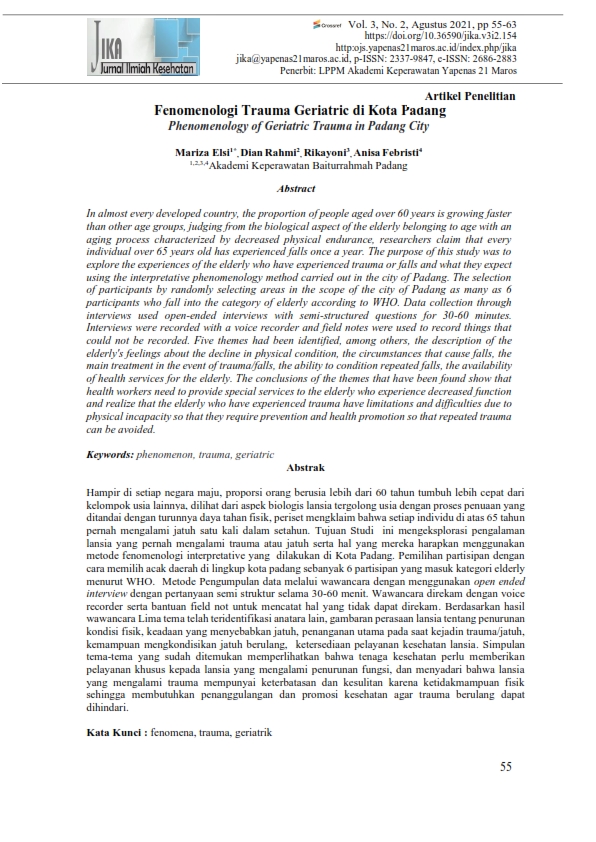Phenomenology of Geriatric Trauma in Padang City
DOI:
https://doi.org/10.36590/jika.v3i2.154Keywords:
phenomeno, trauma, geriatricAbstract
In almost every developed country, the proportion of people aged over 60 years is growing faster than other age groups, judging from the biological aspect of the elderly belonging to age with an aging process characterized by decreased physical endurance, researchers claim that every individual over 65 years old has experienced falls once a year. The purpose of this study was to explore the experiences of the elderly who have experienced trauma or falls and what they expect using the interpretative phenomenology method carried out in the city of Padang. The selection of participants by randomly selecting areas in the scope of the city of Padang as many as 6 participants who fall into the category of elderly according to WHO. Data collection through interviews used open-ended interviews with semi-structured questions for 30-60 minutes. Interviews were recorded with a voice recorder and field notes were used to record things that could not be recorded. Five themes had been identified, among others, the description of the elderly's feelings about the decline in physical condition, the circumstances that cause falls, the main treatment in the event of trauma/falls, the ability to condition repeated falls, the availability of health services for the elderly. The conclusions of the themes that have been found show that health workers need to provide special services to the elderly who experience decreased function and realize that the elderly who have experienced trauma have limitations and difficulties due to physical incapacity so that they require prevention and health promotion so that repeated trauma can be avoided.
Downloads
References
Balimed RS Karang Asem. (2015). Pedoman resiko pasien jatuh. Rumah Sakit BaliMed Karangsem.
BPS. 2015. Statistik Penduduk Usia Lanjut. Badan Pusat Statistik.
Dinkes Padang. 2015. Profil Kesehatan Kota Padang.
Fabio Feldman, H. C. (2008). Falls and the Physical Environment: A Review and a New Multifactorial Falls-Risk Conceptual Framework. National Library of Medicine, 2, 82–95. https://doi.org/https://doi.org/10.1177/000841740807500204.
Jakavonytė-Akstinienė A, & Macijauskienė J. 2016. Falls’ Risk Analysis of Older Patients in Nursing Departments: One Month Study. CBU International Conference Proceedings. 4. 642–646. https://doi.org/10.12955/cbup.v4.825.
JBI. 2011. Dn't fall for it. Falls can be prevented, A guide to preventing falls for older people. JBI World News. Wolters Kluwer PACEsetterS, 2(2), 59. https://doi.org/10.1097/01.jbi.0000393709.59554.7a.
Jeffrey M.Caterino. 2010. Identification of an age cutoff for increased mortality in patients with elderly trauma. The American Journal of Emergency Medicine, 28(2), 151–158.
Kemenkes RI. 2013. Gambaran kesehatan lanjut usia di Indonesia. Buleti Jendela Data dan Informasi Kesehatan. 1-18.
Llompart-Pou JA, Pérez-Bárcena J, Chico-Fernández M, Sánchez-Casado M, Raurich JM. 2017. Severe trauma in the geriatric population. World J Crit Care Med. 6(2): 99–106. 10.5492/wjccm.v6.i2.99.
Qodir A. 2015. Penatalaksanaan Pasien Lansia Dengan Trauma. Jurnal Ilmiah Kesehatan Media Husada. 4(1): 67–74. https://doi.org/10.33475/jikmh.v4i1.168.
Radebaugh TS, Bahner CA, Ballard-Reisch D, Epp M, Hale LS, Hanley R, Kendrick K, Rogers ME, Rogers NL. 2011. Falling less in Kansas: Development of a fall risk reduction toolkit. Journal of Aging Research. 2011. https://doi.org/10.4061/2011/532079.
Revananda T. 2015. Hubungan Konsep Diri Dengan Penerimaan Diri Pada Lansia Di Panti Sosial Tresna Werdha Budhi Luhur Kasongan Bantul Yogyakarta. [skripsi]. Universitas 'Aisyiyah Yogyakarta.
Rodgers V. 2008. Gerontological Nursing: Competencies for Care. Journal of Clinical Nursing. 17(4): 564-564. https://doi.org/10.1111/j.1365-2702.2006.01921.x.
Sabatini SN, Kusuma HE, Tambunan L. 2015. Faktor Eksternal Risiko Jatuh Lansia: Studi Empiris. Prosiding Temu Ilmiah IPLBI, 1, 30–31.
Sari YP. 2015. Hubungan tingkat kemandirian aktivitas sehari hari dengan Resiko jatuh pada lansia di PSTW Unit Budi Luhur Kasongan Bantul Yogyakarta.[Skripsi]. Stikes 'Aisyiyah yogyakarta.
Susilowati IH, Sabarinah S, Nugraha S, Prayoga B. 2019. Buku Monograf I-FRAT Indonesian Fall Risk Assesement Tool, Alat Deteksi Risiko Jatuh Pada Lansia. Depok: Rajawali Press.
Suyasa IGPD, Suyasa NP, Susanti NLPD. 2016. Studi deskriptif tentang isi panduan pencegahan dan penanganan jatuh pada lansia. Seminar Nasional.
Yati Afianti, Rachmawati IN. (2014). Metodologi Penelitian Kualitatif dalam Riset Keperawatan (1st ed.). Jakarta: Rajawali Press.









